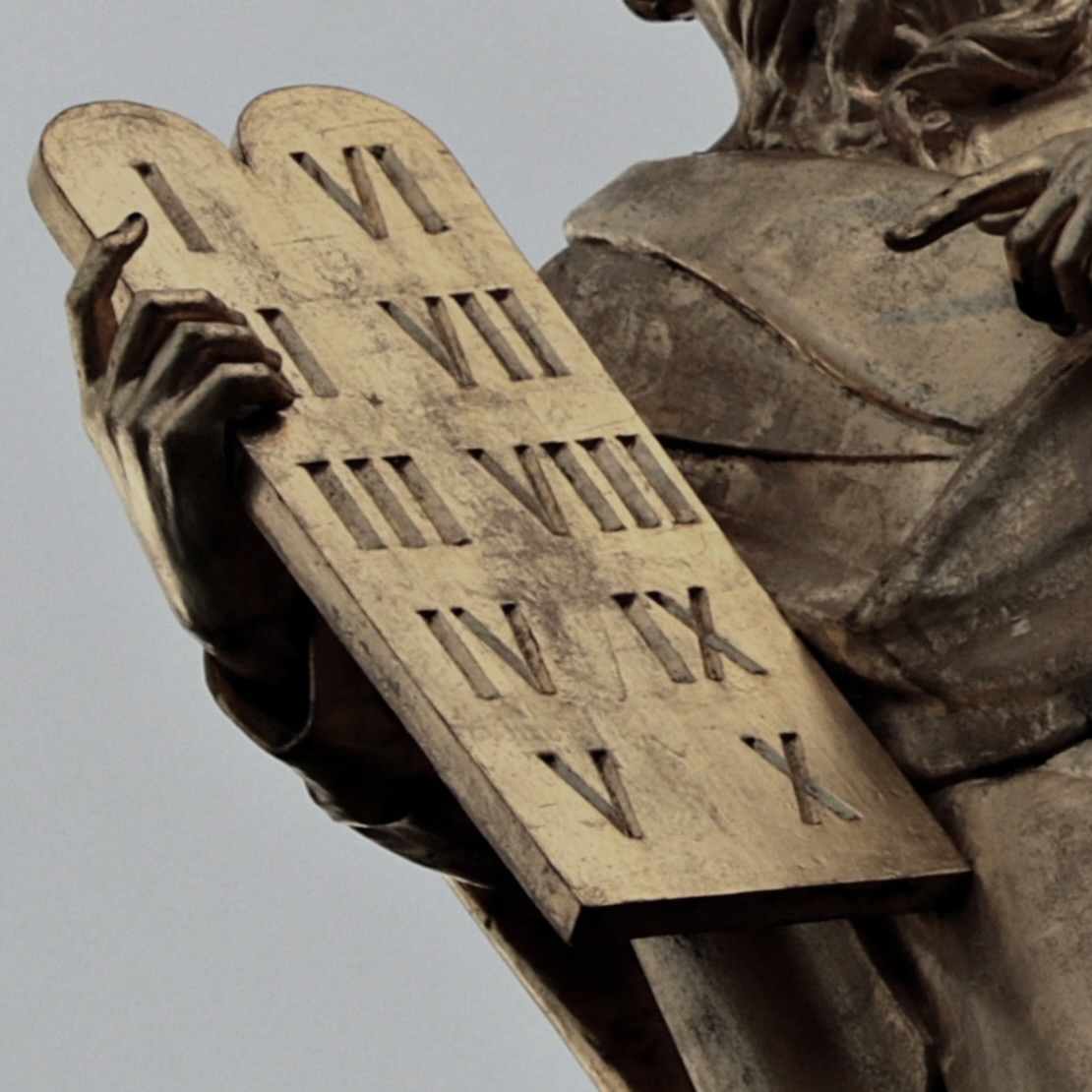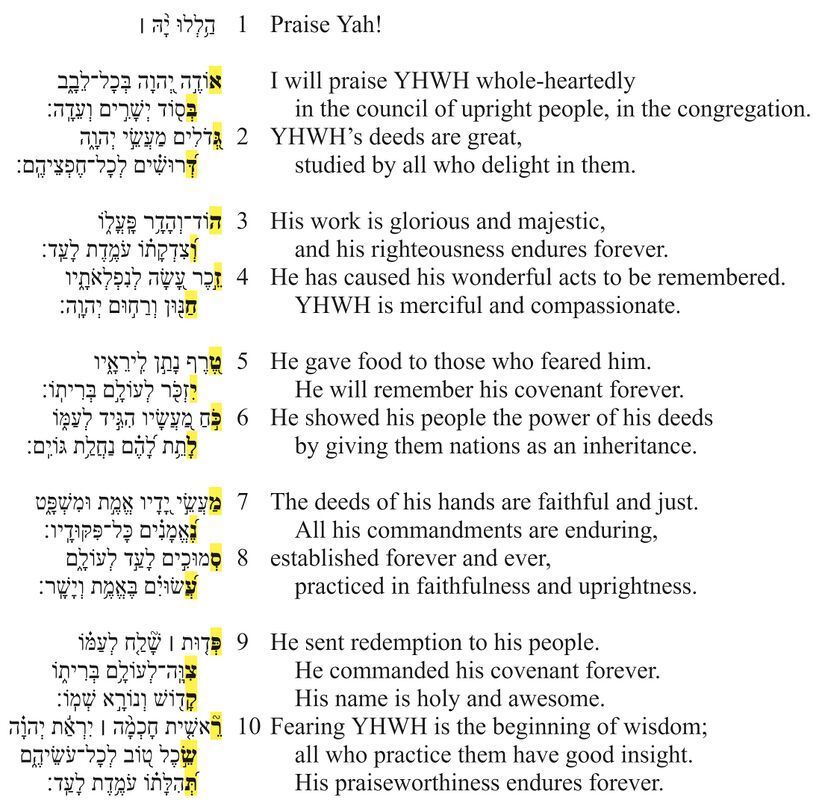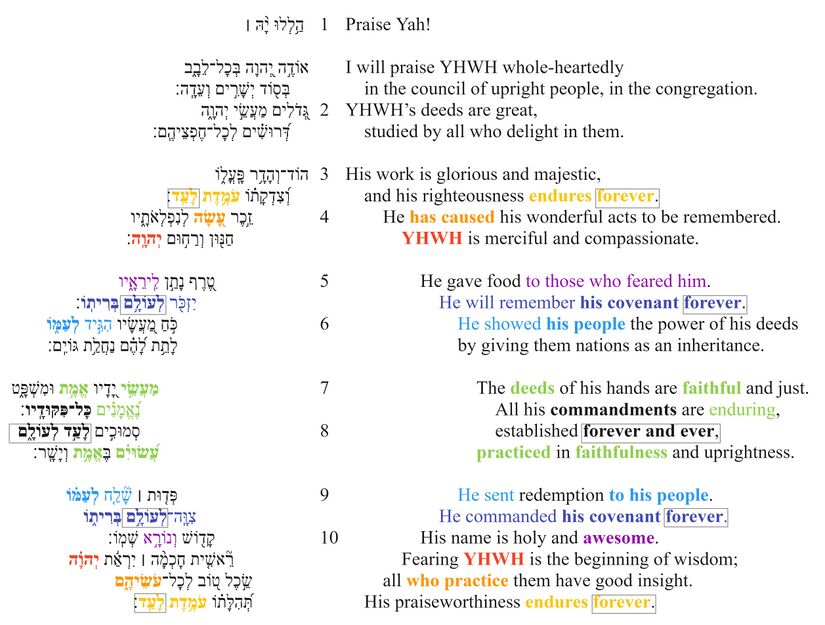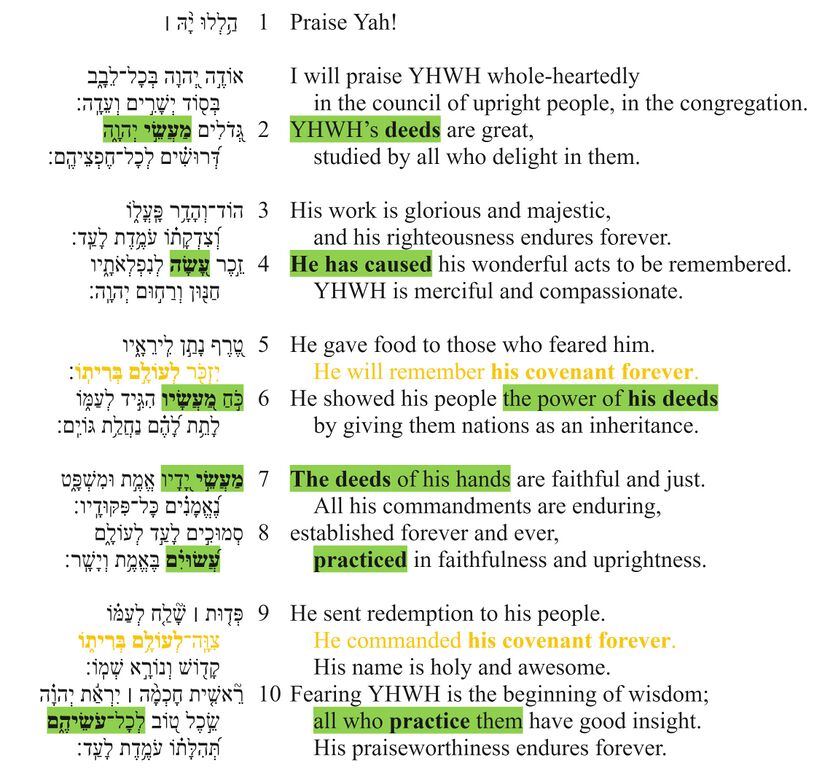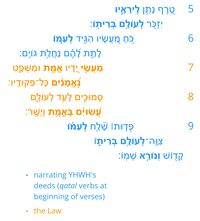Psalm 111 Poetic Features
Poetic Features
In poetic features, we identify and describe the “Top 3 Poetic Features” for each Psalm. Poetic features might include intricate patterns (e.g., chiasms), long range correspondences across the psalm, evocative uses of imagery, sound-plays, allusions to other parts of the Bible, and various other features or combinations of features. For each poetic feature, we describe both the formal aspects of the feature and the poetic effect of the feature. We assume that there is no one-to-one correspondence between a feature’s formal aspects and its effect, and that similar forms might have very different effects depending on their contexts. The effect of a poetic feature is best determined (subjectively) by a thoughtful examination of the feature against the background of the psalm’s overall message and purpose.
YHWH's Deeds from A to Z
If an emendation or revocalization is preferred, that emendation or revocalization will be marked in the Hebrew text of all the visuals.
| Emendations/Revocalizations legend | |
|---|---|
| *Emended text* | Emended text, text in which the consonants differ from the consonants of the Masoretic text, is indicated by blue asterisks on either side of the emendation. |
| *Revocalized text* | Revocalized text, text in which only the vowels differ from the vowels of the Masoretic text, is indicated by purple asterisks on either side of the revocalization. |
Feature
Psalm 111 is an acrostic poem, in which each line begins with a successive letter of the Hebrew alphabet (cf. Ps. 112).
Effect
The alphabet is a symbol of completeness.[1] In an acrostic poem, the poet takes a topic (e.g., Torah [Ps. 119], or the virtuous woman [Prov. 31]) and expounds on it completely (from every possible angle), so that the reader walks away with a high-resolution image of the topic (i.e., he/she understands it “from A to Z”). In Psalm 111, the topic is "YHWH's deeds" (מַעֲשֵׂי יְהוָה).
Eternal Commands
If an emendation or revocalization is preferred, that emendation or revocalization will be marked in the Hebrew text of all the visuals.
| Emendations/Revocalizations legend | |
|---|---|
| *Emended text* | Emended text, text in which the consonants differ from the consonants of the Masoretic text, is indicated by blue asterisks on either side of the emendation. |
| *Revocalized text* | Revocalized text, text in which only the vowels differ from the vowels of the Masoretic text, is indicated by purple asterisks on either side of the revocalization. |
Feature
The repetition of roots, words, and phrases forms a chiasm that spans vv. 3b–10c.[2]
a. עֹמֶדֶת לָעַֽד (v. 3b)
b. עָשָׂה (v. 4a)
c. יְהוָֽה (v. 4b)
d. לִֽירֵאָיו (v. 5a)
e. לְעוֹלָם בְּרִיתוֹ (v. 5b)
f. לְעַמּוֹ (v. 6a)
g. מַעֲשֵׂי...אֱמֶת (v. 7a)
X. נֶאֱמָנִים כָּל־פִּקּוּדָֽיו סְמוּכִים לָעַד לְעוֹלָם (v. 7b–8a)
g.' עֲשׂוּיִם בֶּאֱמֶת (v. 8b)
f.' לְעַמּוֹ (v. 9a)
e.' לְעוֹלָם בְּרִיתוֹ (v. 9b)
d.' וְנוֹרָא (v. 9c)
c.' יְהוָה (v. 10a)
b.' עֹשֵׂיהֶם (v. 10b)
a.' עֹמֶדֶת לָעַֽד (v. 10c)
At the center of the chiasm is the three-fold repetition of the root אמן, the phrase כָּל־פִּקּוּדָֽיו, and the phrase לָעַד לְעוֹלָם (cf. the concentric references to time: a/a': לָעַד; e/e': לְעוֹלָם; X: לָעַד לְעוֹלָם). The centrality of כָּל־פִּקּוּדָֽיו is reinforced by the fact that this phrase is the subject of three consecutive clauses (vv. 7b, 8ab) and is still active in the discourse in v. 10, such that it is available for pronominal reference (עֹשֵׂיהֶם in v. 10b).
Effect
Psalm 111 is a celebration of YHWH's deeds. These deeds include redeeming his people from Egypt (v. 9a), sustaining them in the wilderness (v. 5a) and giving them the promised land (v. 6). Although the psalm celebrates all of these deeds (and more), the chiastic structure highlights one deed in particular: YHWH's commands (v. 7b). By placing the "commands" at the center of the chiasm, describing them with the phrase "forever and ever", and making them the subject of three consecutive verses (vv. 7b–8b), the "commands" receive special prominence. Furthermore, the "commands" are surrounded by the threefold repetition of the root אמן. YHWH's commands are both given (by him) in faithfulness and they are to be done (by his people) in faithfulness. This movement at the center of the chiasm (vv. 7–8) from YHWH's faithfulness to his people's faithfulness is part of a larger movement within the chiasm as a whole: the first half of the chiasm (vv. 3–7) focuses on YHWH's character and deeds and the second half (vv. 8b–10) focuses more on the implications for YHWH's people (who, having been redeemed by him, keep his covenant, fear him, and praise him). The pivotal point of this movement from YHWH's deeds to the deeds of his people are YHWH's eternal commands (v. 7b-8a).
Great Deeds
If an emendation or revocalization is preferred, that emendation or revocalization will be marked in the Hebrew text of all the visuals.
| Emendations/Revocalizations legend | |
|---|---|
| *Emended text* | Emended text, text in which the consonants differ from the consonants of the Masoretic text, is indicated by blue asterisks on either side of the emendation. |
| *Revocalized text* | Revocalized text, text in which only the vowels differ from the vowels of the Masoretic text, is indicated by purple asterisks on either side of the revocalization. |
Feature
The root עשׂה occurs six times in Ps. 111 (vv. 2a, 4a, 6a, 7a, 8b, 10b), one time in each section and twice in the fourth section. The first four occurrences refer to YHWH's deeds (vv. 2a, 4a, 6a, 7a), and the last two occurrences refer to the deeds of YHWH's people (vv. 8b, 10b).
Another repetition in the psalm is phrase לְעוֹלָם בְּרִיתוֹ, which occurs in v. 5b and v. 9b.
Effect
The topic of Psalm 111 is YHWH's deeds (cf. vv. 1–2), so it is no surprise that the word "deeds" should occur so many times. The repetition thus functions to highlight the theme of the psalm. But the repetition also functions to make a point about how people ought to respond to YHWH's deeds. By using the word עשׂה twice with people as the agent, the psalm makes the point that the proper response to YHWH's deeds of faithfulness consists of deeds of faithful obedience. In short, the covenant relationship between YHWH and his people is to be characterized by doing (עשׂה). YHWH does great deeds for his people (vv. 2a, 4a, 6a, 7a), and, in response, his people do his commands (vv. 8b, 10b).
The two-way nature of this covenant relationship is emphasized also by the repetition of the phrase לְעוֹלָם בְּרִיתוֹ. The first time the phrase occurs (v. 5b) the focus is on YHWH keeping his side of the covenant. The second time the phrase occurs (v. 9b), the focus is on the people's obligation to keep their side of the covenant.
Repeated Roots
The repeated roots table is intended to identify the roots which are repeated in the psalm.
| Repeated Roots legend | |
|---|---|
| Divine name | The divine name is indicated by bold purple text. |
| Roots bounding a section | Roots bounding a section, appearing in the first and last verse of a section, are indicated by bold red text. |
| Roots occurring primarily in the first section are indicated in a yellow box. | |
| Roots occurring primarily in the third section are indicated in a blue box. | |
| Roots connected across sections are indicated by a vertical gray line connecting the roots. | |
| Section boundaries are indicated by a horizontal black line across the chart. | |
Notes
- The most frequently occurring word/root in the psalm is עשה (x6).
- The noun מעשה occurs 3 times.
- The verb עשה occurs 3 times.
- The root הלל occurs at the beginning (v. 1) and end (v. 10c) of the psalm.
- The quantifier כל occurs four times in the psalm. Especially striking is the correspondence between לְכָל־חֶפְצֵיהֶֽם (v. 2) and לְכָל־עֹשֵׂיהֶם (v. 10).
- In two cases, repeated roots occur with identical form and in an identical sequence.
- עֹמֶדֶת לָעַד (vv. 3b. 10c)
- לְעוֹלָם בְּרִיתוֹ (vv. 5b, 9b)
- The phrase לְעַמּוֹ is also repeated with an identical form in both v. 6a and v. 9a.
- The unmistakable repetition of לְעוֹלָם בְּרִיתוֹ and לְעַמּוֹ are part of a larger chiasm that spans vv. 5-9.
- The chiasm begins and ends with the root ירא (vv. 5a, 9c).
- Near the center of the chiasm, the combination of עשה and אמת occurs in v. 7a and v. 8b.
- The chiasm in vv. 5-9 is flanked on either side by the mention of YHWH's name (vv. 4b, 10a).
- Within the chiasm, YHWH's name is not mentioned.
- Some repetitions have no obvious structural function apart from short-range cohesion. E.g.,
- זכר (vv. 4-5)
- נתן (vv. 5-6)
- ירא (vv. 9-10)
- Two of these (זכר and ירא) stitch the seam between the embedded chiasm and the rest of the psalm.
